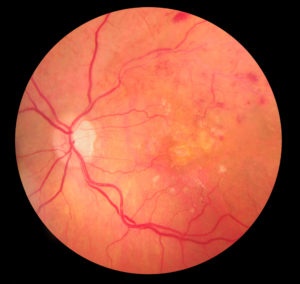Central Retinal Vein Occlusion (CRVO)


- Central Retinal Vein Occlusion (CRVO)
- Branch Retinal Vein Occlusion (BRVO)
- Central Retinal Artery Occlusion (CRAO)
- Branch Retinal Artery Occlusion (BRAO)
A central retinal vein usually causes painless loss of vision, occurs in one eye and is often unrelated to systemic disease. Vein occlusions cause significant bleeding into the retina.
Branch retinal vein occlusions (BRVO) differ from CRVO by the amount of retina that is involved. BRVO usually involves less than 50% of the retina.
Symptoms of CRVO
Central retinal vein occlusions usually cause significant vision loss. For example, many patients with a CRVO are rendered legally blind in that eye. Legally blind is grossly defined as vision less than 20/200.
As mentioned above, the entire retina is involved with a “central” retina occlusion. Hence, the macula is always involved.
Sudden painless loss of vision are the hallmarks of all vascular occlusions. Vision loss is usually significant and the prognosis for improvement is limited.
Bilateral (both eyes) CRVO are uncommon.
Complications of CRVO
Blood and fluid backup into the surrounding retinal tissue when any vein occludes or blocks. The situation is very similar to a car running over a garden hose. Pressure builds up in the hose and water will be forced to leak out of the hose.
In the eye, blood and fluid leech out of the normal retinal blood vessels. Macular edema, swelling of the macula, occurs in all patient with CRVO and some patients with the related branch retinal vein occlusion (where the entire retina is not involved).
Loss of vision occurs from lack of normal blood flow and macular edema.
Neovascular glaucoma can result from CRVO. Neovascular glaucoma can occur in any situation where there is insufficient blood supply to the retina. It is different than other types of glaucoma in that it results only as a complication to certain retinal disorders.
As a result of insufficient blood supply, abnormal “neovascular” blood vessels can form inside the eye and block the normal internal drainage mechanism of the eye. High eye pressure can result causing severe pain and potential blindness.
This is the worst complication of a central retinal vein occlusion. Patients with CRVO must be monitored for signs of this painful type of glaucoma. It can be prevented if caught in time. .
Treatment of CRVO
Treatment of CRVO is focused on reducing macular swelling. Present treatments involve laser, injections of anti-VEGF medications or steroids.
Treating macular edema in cases of central retinal vein occlusion can be difficult. Even with successful treatment, vision does not improve as often as with other causes of macular swelling, such as BRVO or diabetic macular edema.
Lucentis, Eylea and Ozuredex are FDA approved medications given by injection to treat macular edema from CRVO. Avastin is also commonly used, but is not specifically approved for the treatment of CRVO.


